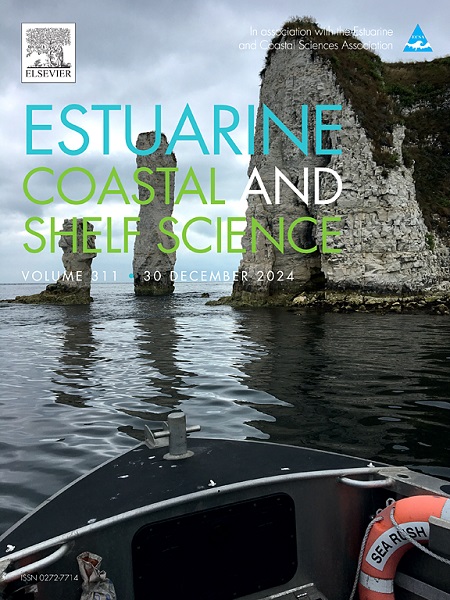Coastal exposure and artificialization: Drivers of shell shape variation in intertidal limpets
IF 2.6
3区 地球科学
Q1 MARINE & FRESHWATER BIOLOGY
引用次数: 0
Abstract
The level of exposure and the degree of coastal urbanization are key environmental and human-related factors that significantly affect the spatial distribution of species in different environments. Intertidal species show morphological adaptations to these influences, but little research has been done on how shell shape varies due to the island effect, including factors like island orientation and substrate type. This study aims to analyze the dorsal shell phenotypic variability of the limpets Patella aspera and Patella crenata, in response to island orientation (North vs. East) and different substrate types (Natural: platform and rocks; Artificial: wave breakers), on the island of Gran Canaria, using geometric morphometric analysis. Our findings support the hypothesis that these limpet species exhibit phenotypic plasticity in response to wave exposure influenced by island orientation and coastal artificialization. Oval shapes with wider and flattened shells, displaying greater shell lengths, on waveswept shores may be explained by the need for a larger foot to ensure attachment to substrate, thereby increasing resistance to dislodgement by wave action. In contrast, more rounded shapes with taller and narrower shells in sheltered environments can accommodate a smaller foot as an adaptation against thermal and desiccation stress. The substrate plays a secondary role in influencing the shell morphology, as slight variations were observed between natural and artificial substrates, particularly in body size, regardless of wave exposure. This phenotypic plasticity may lead to spatial segregation, enabling the species to exploit diverse habitats and reduce intraspecific and interspecific competition. The present study emphasizes the need to conserve intertidal species, particularly along the northern coast of Gran Canaria, by accounting for local responses, implementing targeted monitoring and protection efforts, and preserving the diverse phenotypic traits and plasticity of limpets on both protected and full-access shores amidst coastal sprawl and anthropogenic global change.
海岸暴露和人工:潮间带帽贝贝壳形状变化的驱动因素
暴露水平和沿海城市化程度是影响不同环境下物种空间分布的关键环境因素和人为因素。潮间带物种对这些影响表现出形态上的适应,但关于贝壳形状如何因岛屿效应而变化的研究很少,包括岛屿方向和基质类型等因素。本研究旨在分析宽膝帽贝和绿膝帽贝的背壳表型变异,以响应岛屿朝向(北与东)和不同基质类型(天然:平台和岩石;在大加那利岛上使用几何形态计量学分析的人造:破浪器)。我们的研究结果支持了这样的假设,即这些帽贝物种在受岛屿朝向和海岸人工影响的波浪暴露中表现出表型可塑性。在波浪冲刷的海岸上,具有更宽更平坦外壳的椭圆形,显示出更大的外壳长度,这可能是因为需要更大的足部来确保附着在基材上,从而增加对波浪作用的位移的抵抗力。相比之下,在有遮蔽的环境中,更圆的形状和更高更窄的外壳可以适应更小的脚,以适应热和干燥的压力。底物在影响壳形态方面起次要作用,因为在自然底物和人工底物之间观察到轻微的变化,特别是在体大小方面,无论波浪暴露如何。这种表型可塑性可能导致空间隔离,使物种能够利用多样化的栖息地,减少种内和种间的竞争。本研究强调了保护潮间带物种的必要性,特别是在大加那利岛北部海岸,通过考虑当地的反应,实施有针对性的监测和保护工作,并在沿海扩张和人为全球变化的情况下,在受保护和全面进入的海岸上保持帽贝的多样性表型特征和可塑性。
本文章由计算机程序翻译,如有差异,请以英文原文为准。
求助全文
约1分钟内获得全文
求助全文
来源期刊
CiteScore
5.60
自引率
7.10%
发文量
374
审稿时长
9 months
期刊介绍:
Estuarine, Coastal and Shelf Science is an international multidisciplinary journal devoted to the analysis of saline water phenomena ranging from the outer edge of the continental shelf to the upper limits of the tidal zone. The journal provides a unique forum, unifying the multidisciplinary approaches to the study of the oceanography of estuaries, coastal zones, and continental shelf seas. It features original research papers, review papers and short communications treating such disciplines as zoology, botany, geology, sedimentology, physical oceanography.

 求助内容:
求助内容: 应助结果提醒方式:
应助结果提醒方式:


